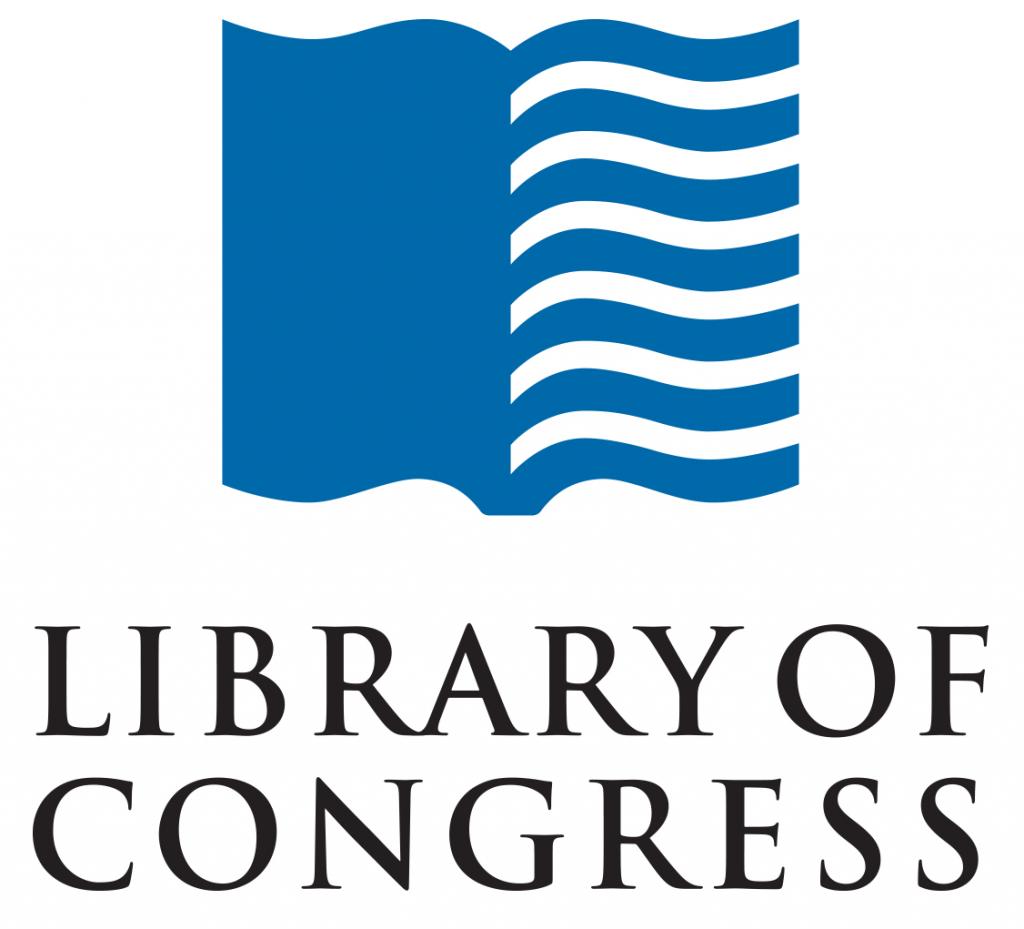from May. 4, 1865
Home of Abraham Lincoln
-
Full Title
Home of Abraham Lincoln
-
Description
Stereographic photograph of Lincoln's home draped in mourning cloth on the day of his funeral.
-
Source
Library of Congress, Prints and Photographs Division, LC-DIG-stereo-1s04301
-
Rights
This item is in the public domain and may be reproduced and used for any purpose, including research, teaching, private study, publication, broadcast or commercial use, with proper citation and attribution.
-
Tags
-
Cite this Item
Ridgway Glover. "Home of Abraham Lincoln". Remembering Lincoln. Web. Accessed June 24, 2025. https://rememberinglincoln.fords.org/node/1166
-
Creator
Ridgway Glover
-
Date
May 4, 1865
-
Dimensions
8 x 17 cm
from May. 4, 1865
Home of Abraham Lincoln
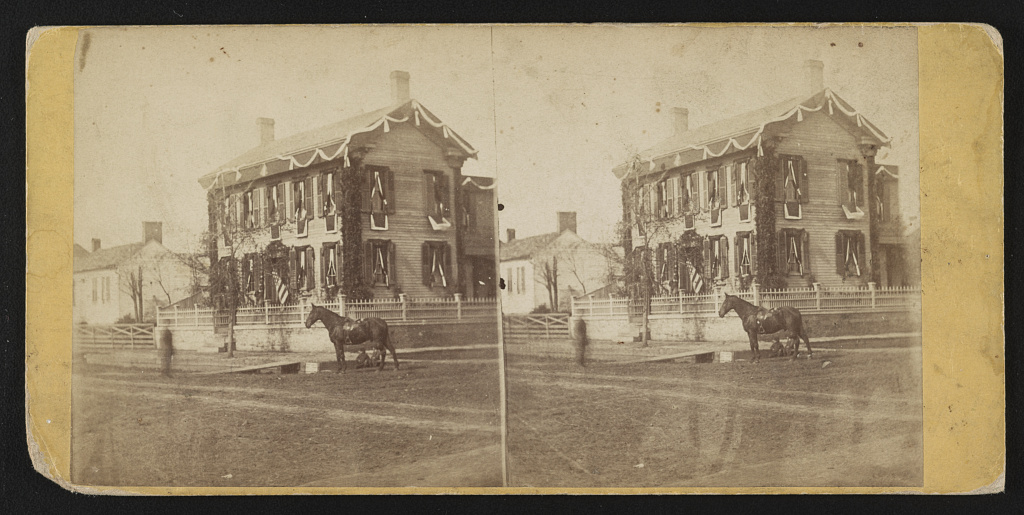
-
Description
Stereographic photograph of Lincoln's home draped in mourning cloth on the day of his funeral.
-
Source
Library of Congress, Prints and Photographs Division, LC-DIG-stereo-1s04301
-
Rights
This item is in the public domain and may be reproduced and used for any purpose, including research, teaching, private study, publication, broadcast or commercial use, with proper citation and attribution.
-
Creator
Ridgway Glover
-
Date
May 4, 1865
-
Dimensions
8 x 17 cm
from May. 1, 1865
Lincoln's Tomb
-
Full Title
Lincoln's Tomb
-
Description
A stereographic photograph of Lincoln's tomb in Oak Ridge, Cemetery in Springfield, Illinois.
-
Source
Library of Congress, Prints and Photographs Division, LC-DIG-stereo-1s04305
-
Rights
This item is in the public domain and may be reproduced and used for any purpose, including research, teaching, private study, publication, broadcast or commercial use, with proper citation and attribution.
-
Tags
-
Cite this Item
C.H. Hall . "Lincoln's Tomb". Remembering Lincoln. Web. Accessed June 24, 2025. https://rememberinglincoln.fords.org/node/1163
-
Creator
C.H. Hall
-
Date
May 1, 1865
-
Dimensions
8 x 17 cm
from May. 1, 1865
Lincoln's Tomb
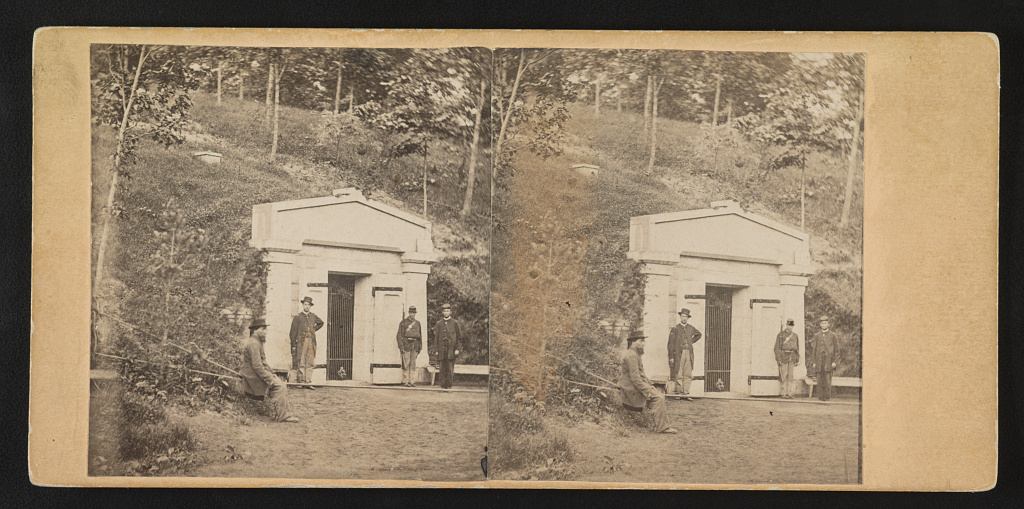
-
Description
A stereographic photograph of Lincoln's tomb in Oak Ridge, Cemetery in Springfield, Illinois.
-
Source
Library of Congress, Prints and Photographs Division, LC-DIG-stereo-1s04305
-
Rights
This item is in the public domain and may be reproduced and used for any purpose, including research, teaching, private study, publication, broadcast or commercial use, with proper citation and attribution.
-
Creator
C.H. Hall
-
Date
May 1, 1865
-
Dimensions
8 x 17 cm
from May. 1, 1865
Removal of Lincoln's body
-
Full Title
Removal of Lincoln's body
-
Description
This photo of workmen using a crane to remove slabs, was taken during the 1899–1901 rebuilding and restoration program of Lincoln's grave.
-
Source
-
Rights
This item is in the public domain and may be reproduced and used for any purpose, including research, teaching, private study, publication, broadcast or commercial use, with proper citation and attribution.
-
Tags
-
Cite this Item
unknown. "Removal of Lincoln's body". Remembering Lincoln. Web. Accessed June 24, 2025. https://rememberinglincoln.fords.org/node/1148
-
Creator
unknown
-
Date
April 1901
from May. 1, 1865
Removal of Lincoln's body
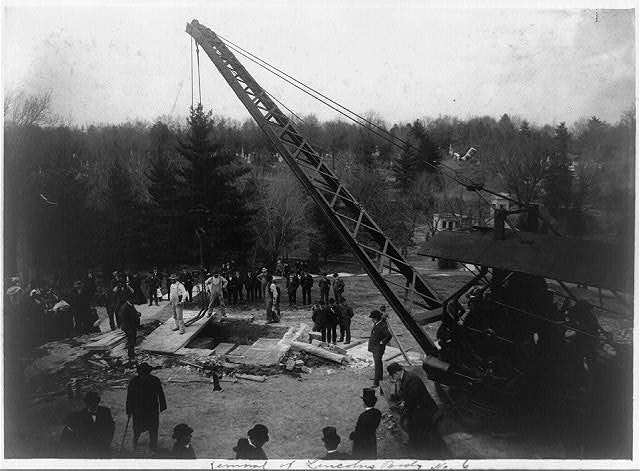
-
Description
This photo of workmen using a crane to remove slabs, was taken during the 1899–1901 rebuilding and restoration program of Lincoln's grave.
-
Source
-
Rights
This item is in the public domain and may be reproduced and used for any purpose, including research, teaching, private study, publication, broadcast or commercial use, with proper citation and attribution.
-
Creator
unknown
-
Date
May 1, 1865
from Jun. 10, 1865
Mourners at Abraham Lincoln's Funeral in Springfield, IL
-
Full Title
Mourners at Abraham Lincoln's Funeral in Springfield, IL - Frank Leslie's Illustrated Newspaper Drawing
-
Description
In the June 10th, 1865 edition of Frank Leslie's Illustrated Weekly newspaper, this image was printed next to an article about President Lincoln's funeral in Springfield, Illinois. It shows President Lincoln's eldest son, Robert, at his tomb and others raising money to build a memorial to President Lincoln. President Lincoln was buried on May 4, 1865 at Oak Ridge Cemetery. The illustrated literary and news publication was founded in 1855 and continued until 1922. It was one of several started by publisher and illustrator Frank Leslie. Leslie was a British engraver who came to the United States in 1848. The Illustrated Weekly followed a tested and proven formula of carefully combining elements of war, politics, art, science, travel and exploration, literature and the fine arts in each issue, enhanced with between 16 and 32 illustrations. By 1897 its circulation had grown to an estimated 65,000 copies.
-
Source
The Lincoln Financial Foundation Collection
-
Rights
To request rights and permissions to use Lincoln Financial Foundation Collection images in research or publications, please download our image rights permission form: https://www.lincolncollection.org/access/image-rights-permissions/.
-
Tags
-
Cite this Item
Thomas Hogan. "Mourners at Abraham Lincoln's Funeral in Springfield, IL - Frank Leslie's Illustrated Newspaper Drawing". Frank Leslie. Remembering Lincoln. Web. Accessed June 24, 2025. https://rememberinglincoln.fords.org/node/1111
-
Creator
Thomas Hogan
-
Publisher
Frank Leslie
-
Date
June 10, 1865
from Jun. 10, 1865
Mourners at Abraham Lincoln's Funeral in Springfield, IL - Frank Leslie's Illustrated Newspaper Drawing
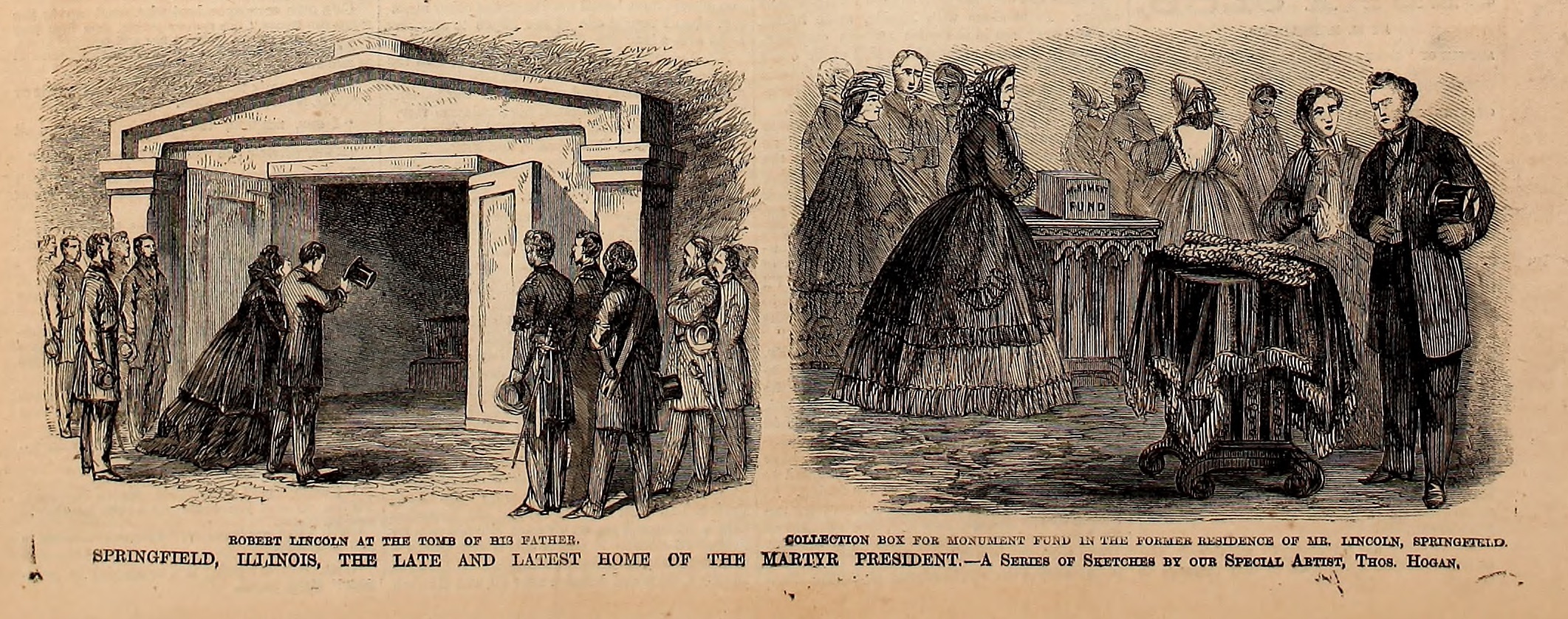
-
Description
In the June 10th, 1865 edition of Frank Leslie's Illustrated Weekly newspaper, this image was printed next to an article about President Lincoln's funeral in Springfield, Illinois. It shows President Lincoln's eldest son, Robert, at his tomb and others raising money to build a memorial to President Lincoln. President Lincoln was buried on May 4, 1865 at Oak Ridge Cemetery. The illustrated literary and news publication was founded in 1855 and continued until 1922. It was one of several started by publisher and illustrator Frank Leslie. Leslie was a British engraver who came to the United States in 1848. The Illustrated Weekly followed a tested and proven formula of carefully combining elements of war, politics, art, science, travel and exploration, literature and the fine arts in each issue, enhanced with between 16 and 32 illustrations. By 1897 its circulation had grown to an estimated 65,000 copies.
-
Source
The Lincoln Financial Foundation Collection
-
Rights
To request rights and permissions to use Lincoln Financial Foundation Collection images in research or publications, please download our image rights permission form: https://www.lincolncollection.org/access/image-rights-permissions/.
-
Creator
Thomas Hogan
-
Publisher
Frank Leslie
-
Date
June 10, 1865
from May. 20, 1865
John Wilkes Booth "Buried at Sea"
-
Full Title
John Wilkes Booth "Buried at Sea" - Frank Leslie's Illustrated Newspaper Drawing
-
Description
In the May 20th, 1865 edition of Frank Leslie's Illustrated Weekly newspaper, this image was printed inaccurately depicting the burial of President Lincoln's assassin, actor John Wilkes Booth. The federal government was worried what the public would do if they buried the body, so they staged a burial at sea and then secretly buried the assassin in an unmarked location. In 1869 they released the body to Booth's family and he was reburied in their family plot in Baltimore, Maryland. Frank Leslie's Illustrated Weekly was a literary and news publication founded in 1855 which ran until 1922. It was one of several started by publisher and illustrator Frank Leslie. Leslie was a British engraver who came to the United States in 1848. The Illustrated Weekly followed a tested and proven formula of carefully combining elements of war, politics, art, science, travel and exploration, literature and the fine arts in each issue, enhanced with between 16 and 32 illustrations. By 1897 its circulation had grown to an estimated 65,000 copies.
-
Source
The Lincoln Financial Foundation Collection
-
Rights
To request rights and permissions to use Lincoln Financial Foundation Collection images in research or publications, please download our image rights permission form: https://www.lincolncollection.org/access/image-rights-permissions/.
-
Tags
-
Cite this Item
Frank Leslie. "John Wilkes Booth "Buried at Sea" - Frank Leslie's Illustrated Newspaper Drawing". Frank Leslie . Remembering Lincoln. Web. Accessed June 24, 2025. https://rememberinglincoln.fords.org/node/1110
-
Creator
Frank Leslie
-
Publisher
Frank Leslie
-
Date
May 20, 1865
from May. 20, 1865
John Wilkes Booth "Buried at Sea" - Frank Leslie's Illustrated Newspaper Drawing
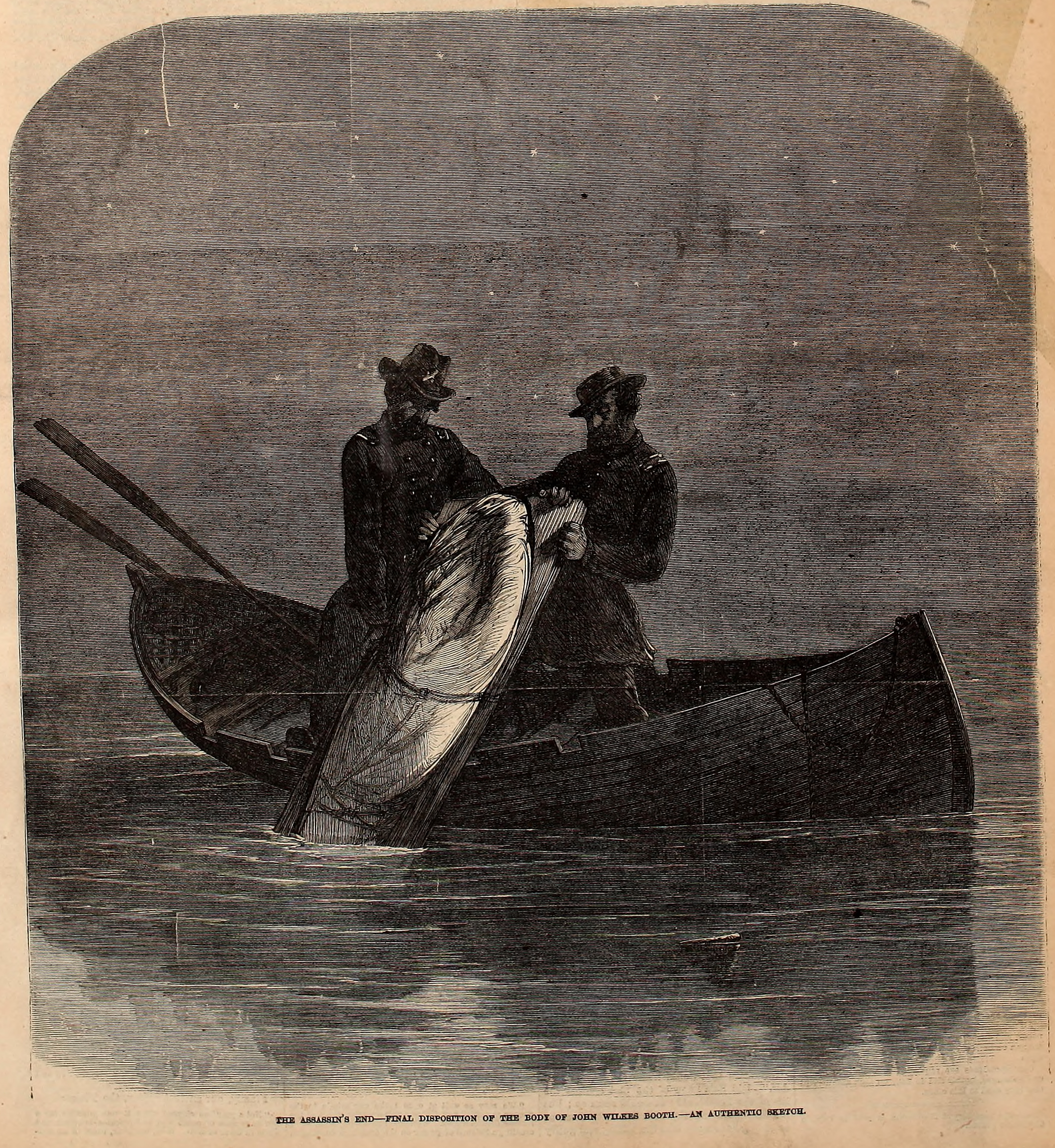
-
Description
In the May 20th, 1865 edition of Frank Leslie's Illustrated Weekly newspaper, this image was printed inaccurately depicting the burial of President Lincoln's assassin, actor John Wilkes Booth. The federal government was worried what the public would do if they buried the body, so they staged a burial at sea and then secretly buried the assassin in an unmarked location. In 1869 they released the body to Booth's family and he was reburied in their family plot in Baltimore, Maryland. Frank Leslie's Illustrated Weekly was a literary and news publication founded in 1855 which ran until 1922. It was one of several started by publisher and illustrator Frank Leslie. Leslie was a British engraver who came to the United States in 1848. The Illustrated Weekly followed a tested and proven formula of carefully combining elements of war, politics, art, science, travel and exploration, literature and the fine arts in each issue, enhanced with between 16 and 32 illustrations. By 1897 its circulation had grown to an estimated 65,000 copies.
-
Source
The Lincoln Financial Foundation Collection
-
Rights
To request rights and permissions to use Lincoln Financial Foundation Collection images in research or publications, please download our image rights permission form: https://www.lincolncollection.org/access/image-rights-permissions/.
-
Creator
Frank Leslie
-
Publisher
Frank Leslie
-
Date
May 20, 1865
from May. 13, 1865
Abraham Lincoln's Coffin
-
Full Title
Abraham Lincoln's Coffin - Frank Leslie's Illustrated Newspaper Drawing
-
Description
In the May 13th, 1865 edition of Frank Leslie's Illustrated Weekly newspaper, this image was printed next to an article about President Lincoln's funeral. The illustrated literary and news publication was founded in 1855 and continued until 1922. It was one of several started by publisher and illustrator Frank Leslie. Leslie was a British engraver who came to the United States in 1848. The Illustrated Weekly followed a tested and proven formula of carefully combining elements of war, politics, art, science, travel and exploration, literature and the fine arts in each issue, enhanced with between 16 and 32 illustrations. By 1897 its circulation had grown to an estimated 65,000 copies.
-
Source
The Lincoln Financial Foundation Collection
-
Rights
To request rights and permissions to use Lincoln Financial Foundation Collection images in research or publications, please download our image rights permission form: https://www.lincolncollection.org/access/image-rights-permissions/.
-
Tags
-
Cite this Item
Frank Leslie. "Abraham Lincoln's Coffin - Frank Leslie's Illustrated Newspaper Drawing". Frank Leslie. Remembering Lincoln. Web. Accessed June 24, 2025. https://rememberinglincoln.fords.org/node/1109
-
Creator
Frank Leslie
-
Publisher
Frank Leslie
-
Date
May 13, 1865
from May. 13, 1865
Abraham Lincoln's Coffin - Frank Leslie's Illustrated Newspaper Drawing
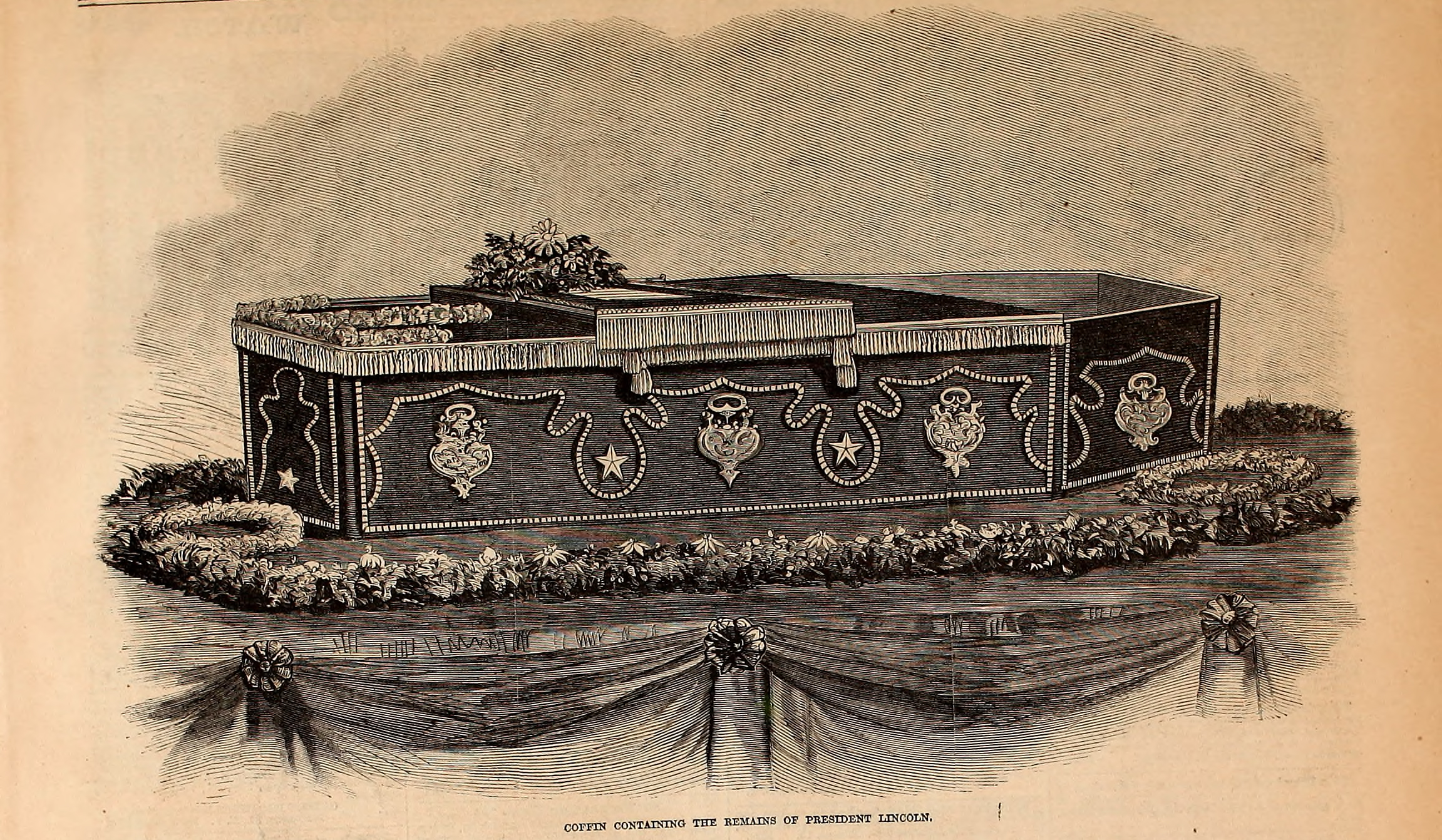
-
Description
In the May 13th, 1865 edition of Frank Leslie's Illustrated Weekly newspaper, this image was printed next to an article about President Lincoln's funeral. The illustrated literary and news publication was founded in 1855 and continued until 1922. It was one of several started by publisher and illustrator Frank Leslie. Leslie was a British engraver who came to the United States in 1848. The Illustrated Weekly followed a tested and proven formula of carefully combining elements of war, politics, art, science, travel and exploration, literature and the fine arts in each issue, enhanced with between 16 and 32 illustrations. By 1897 its circulation had grown to an estimated 65,000 copies.
-
Source
The Lincoln Financial Foundation Collection
-
Rights
To request rights and permissions to use Lincoln Financial Foundation Collection images in research or publications, please download our image rights permission form: https://www.lincolncollection.org/access/image-rights-permissions/.
-
Creator
Frank Leslie
-
Publisher
Frank Leslie
-
Date
May 13, 1865
from Mar. 2, 1867
"LINCOLN"
-
Full Title
"LINCOLN": San Antonio Express
-
Description
This article, published by the San Antonio Express on March 2, 1867, contains an interview with William Herndon's law partner. Herndon spoke of Lincoln's romantic ventures in his earlier years. Following the interview, a beautiful description of the grave of Lincoln is provided.
-
Transcription
LINCOLN
A special correspondent of the New York Tribune, writing from Springfield, Ill., relates the following episode in the life of Mr. Lincoln. Mr. Herndon was Mr. Lincoln's law partner. The correspondent says:
"The tenderness of Mr. Lincoln nature romance in early manhood, and as of this Mr. Herndon had spoken in public, I asked particularly about it.
At Sangamon, Illinois, a pretty and high-spirited girl, without fortune, made havoc in many hearts and Mr. Lincoln constituted one of three earnest suitors who wanted her in marriage. She preferred the address of a young merchant of the town, and gave the other two their conge. Her affianced soon afterwards went East to buy goods, but as he returned was taken with brain fever in some wayside town, and lay raving for three months, unknown by name or residence to his entertainers. A rumor started that he had run away to avoid marrying his lady, and waiting some time in vain to hear from him, she received anew the attentions of Mr. Lincoln. About the time when they passed from courtesy to tenderness, and marriage between them was more than hinted at, the sick man returned like a ghost, gauged the condition of affairs, and upbraided the lady with fickleness. She had a delicate sense of honor, and felt keenly the shame of having seemed to trifle with two gentlemen at once; this preyed upon her mind til her body, not very strong, suffered by sympathy, and Mr. Herndon has oral and written testimony that the girl died out of regret at the equivocal position she had unwillingly assumed. The names of all the parties he has given me, but I do not care to print them."
The same writer gives the following beautifully description of the spot where lies all that is mortal of the lamented savior of our country:
"I know of no better illustration of the difference between the real life and the renown of Mr. Lincoln than you get by visiting his grave. A horse railroad, two miles long, leads to it, in the cemetery of Oak Ridge. Behind you is his real life, Springfield, a Western market town, set upon the monotonous prairie, half the year noisy with the chatter of politicians, plethoric with lawyers, for all of whom there is less than enough to do, and savoring much of the frost and the frontier; a pretty prairie city, but capitalized so that what the State has not done for the town, and the people expected it to do, make an unfinished desultoryness. – All at once, as you approach the Sangamon river, the scene changes. Stalwart young oaks of natural growth become plentiful. The landscape is plowed with leafy ravines. Bold knowls start up. – A creek goes plashing around the abrupt hills. Shadow, murmur, and surprise succeed the level life of the city. And among all these mysteries, itself the great mystery of our age, the vault of the President caps a hill, a temporary edifice of brick, and the great drive of one of the handsomest cemeteries in the Union winds with the winding brook beneath it:
"The last
As 'twere the cape of a long ridge of hills,"
and all the white tombs martial it; buttonwood, maple and ash trees cluster at its base; here is to be his monument. – About $75,000 have been collected for it up to this time, and it is supposed the State will vote enough to make $200,000 in all. There is no sweeter spot for a tired life to rest in. It would be blasphemy to mar the dead man's grave with any mere prettiness of marble or smartness of bronze. Let the firey, untamed Western genius be of timid chisel here: "Abraham Lincoln" is a good epitaph if plainly lettered. And, after all, will any monument be like the man, for no such one was ever a sculptur's theme before. Canova could get no notion of Mr. Lincoln. An allegory would be unlike him, a shaft too formal, a statue too inexpressive. If the Pacific railroad could be called by his name, that would be better."
[Transcription by Deborah Taylor.] -
Source
Newsbank
-
Rights
This item is in the public domain and may be reproduced and used for any purpose, including research, teaching, private study, publication, broadcast or commercial use, with proper citation and attribution.
-
Tags
-
Cite this Item
San Antonio Express. ""LINCOLN": San Antonio Express". San Antonio Express. Remembering Lincoln. Web. Accessed June 24, 2025. https://rememberinglincoln.fords.org/node/1103
from Mar. 2, 1867
"LINCOLN": San Antonio Express

-
Description
This article, published by the San Antonio Express on March 2, 1867, contains an interview with William Herndon's law partner. Herndon spoke of Lincoln's romantic ventures in his earlier years. Following the interview, a beautiful description of the grave of Lincoln is provided.
-
Source
Newsbank
-
Rights
This item is in the public domain and may be reproduced and used for any purpose, including research, teaching, private study, publication, broadcast or commercial use, with proper citation and attribution.
-
Creator
San Antonio Express
-
Publisher
San Antonio Express
-
Date
March 2, 1867
-
Material
newspaper
from
Drum played at the funeral of Abraham Lincoln
-
Full Title
Drum played at the funeral of Abraham Lincoln
-
Description
Drum played at the funeral of Abraham Lincoln by W. H. Brooks, a resident of Portland, OR and Hillsboro, OR after 1908. Brooks enlisted in the Union army in 1861 when he was 14 years old and served in the 14th Iowa Regiment in a brigade the Confederates dubbed the "Hornets' Nest" because it so fiercely defended its position in a sunken road at Shiloh, Tennessee. In 1931, Brooks told an Oregonian reporter he had marched more than 800 miles before his discharge from the army. He recounted, "I was in the consolidated drum corps that played in the funeral procession of President Lincoln from the city to Oak Ridge cemetery in May 1865. I saw the president's casket placed in the vault."
-
Source
Oregon Historical Society
-
Rights
Use of this item for research, teaching, and private study is permitted with proper citation and attribution. Reproduction of this item for publication, broadcast, or commercial use requires written permission.
-
Tags
-
Cite this Item
William Henry Brooks, 14th Iowa Regiment. "Drum played at the funeral of Abraham Lincoln". Remembering Lincoln. Web. Accessed June 24, 2025. https://rememberinglincoln.fords.org/node/1041
from
Drum played at the funeral of Abraham Lincoln
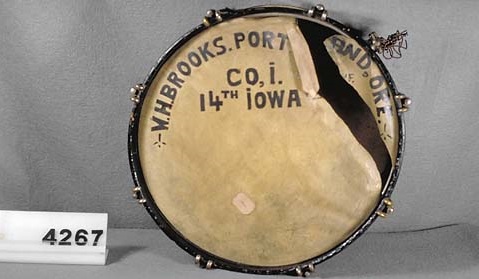
-
Description
Drum played at the funeral of Abraham Lincoln by W. H. Brooks, a resident of Portland, OR and Hillsboro, OR after 1908. Brooks enlisted in the Union army in 1861 when he was 14 years old and served in the 14th Iowa Regiment in a brigade the Confederates dubbed the "Hornets' Nest" because it so fiercely defended its position in a sunken road at Shiloh, Tennessee. In 1931, Brooks told an Oregonian reporter he had marched more than 800 miles before his discharge from the army. He recounted, "I was in the consolidated drum corps that played in the funeral procession of President Lincoln from the city to Oak Ridge cemetery in May 1865. I saw the president's casket placed in the vault."
-
Source
Oregon Historical Society
-
Rights
Use of this item for research, teaching, and private study is permitted with proper citation and attribution. Reproduction of this item for publication, broadcast, or commercial use requires written permission.
-
Creator
William Henry Brooks, 14th Iowa Regiment
-
Dimensions
diameter 16"; depth 9"
from May. 1, 1865
Lincoln's grave
-
Full Title
Lincoln's grave
-
Description
Song for high voice and piano that comments describes President Lincoln as a "martyr of freedom." Sheet music from the Alfred Whital Stern Collection of Lincolniana, Library of Congress Rare Book and Special Collections Division. Associated with the Union side.
-
Transcription
Verse 1
Far out on the plains of the beautiful west,
Whose glory and wonder Columbia adorn,
The martyr of freedom in triumph shall rest,
To bless all the living and all yet unborn;
The hand that hath slain him, how vile, O how vile!
To mar that fair visage so kind and so true!
No more shall assail him whose heart knew no guile,
But wither and perish a doom justly due.
But wither and perish a doom justly due.
Verse 2
O shade of the blessed, a nation in tears,
In sorrow and sadness its loss must deplore,
The God who hath led thee will quell all our fears,
His goodness that gave thee we still will adore;
Sweet peace, gentle sleeper, thy spirit attend,
While men, yes while angels thy praises shall sing,
Against thy blest mem'ry O who dare offend!
And not to its altar his best off'rings bring.
Verse 3
O spirit undying for death none the less,
But like Him who died that the earth might rejoice,
Thou risest victorious the nations to bless;
The bondman's delivrer, America's choice,
The hand that hath slain thee, how vile, O how vile!
To mar thy fair visage, so kind and so true,
No more shall assail thee whose heart knew no guile,
But wither and perish a doom justly due. -
Source
Sheet Music from the Alfred Whital Stern Collection of Lincolniana
-
Rights
Public Domain. Suggested credit line: Alfred Whital Stern Collection of Lincolniana, Library of Congress, Rare Book and Special Collections Division.
-
Tags
-
Cite this Item
Gougler, Isaiah W. (composer & lyricist). "Lincoln's grave". New York: Wm. A. Pond & Co., ca. 1865. Remembering Lincoln. Web. Accessed June 24, 2025. https://rememberinglincoln.fords.org/node/1034
from May. 1, 1865
Lincoln's grave
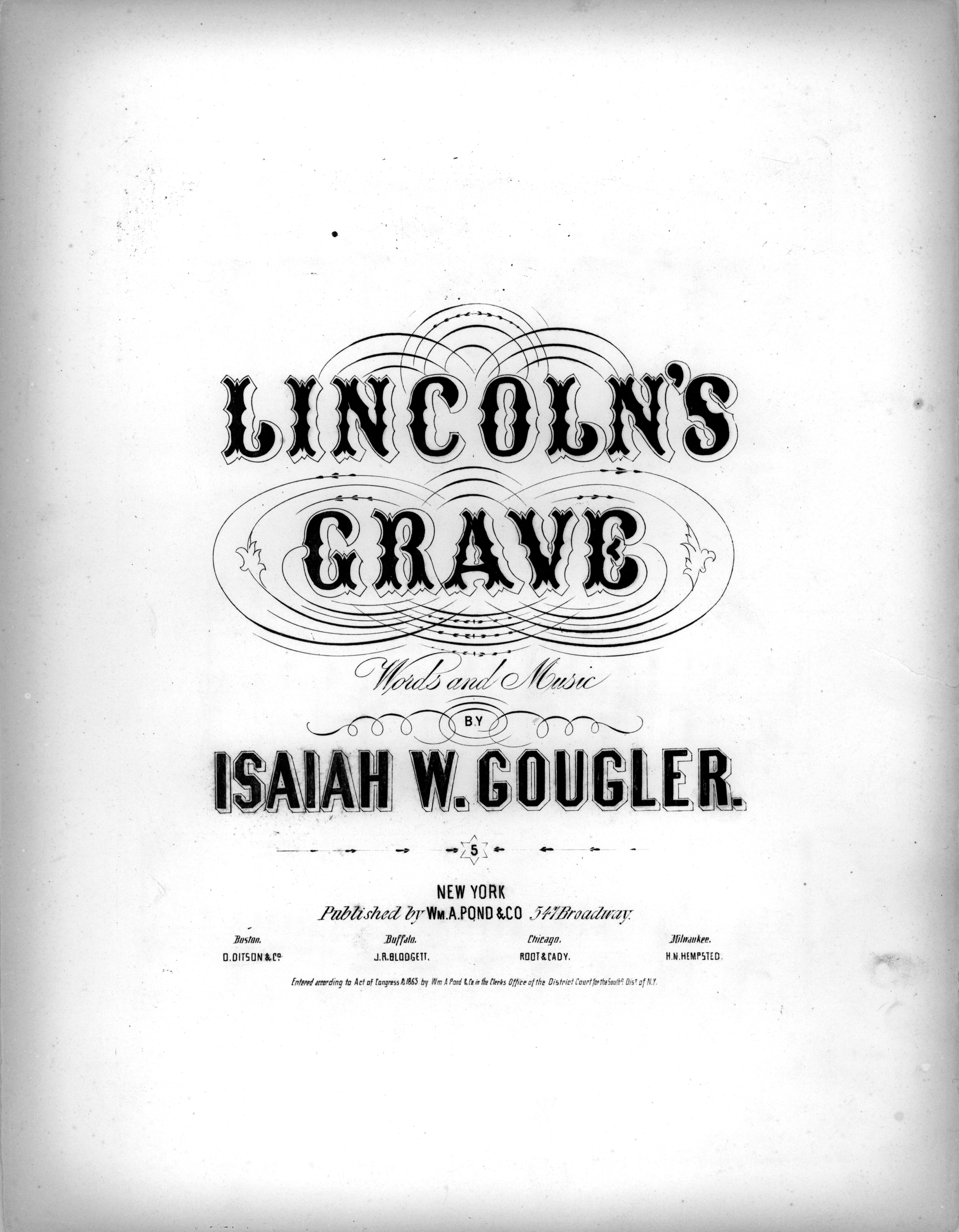
-
Description
Song for high voice and piano that comments describes President Lincoln as a "martyr of freedom." Sheet music from the Alfred Whital Stern Collection of Lincolniana, Library of Congress Rare Book and Special Collections Division. Associated with the Union side.
-
Source
Sheet Music from the Alfred Whital Stern Collection of Lincolniana
-
Rights
Public Domain. Suggested credit line: Alfred Whital Stern Collection of Lincolniana, Library of Congress, Rare Book and Special Collections Division.
-
Creator
Gougler, Isaiah W. (composer & lyricist)
-
Publisher
New York: Wm. A. Pond & Co., ca. 1865
-
Date
May 1, 1865
-
Material
Sheet Music
from May. 1, 1865
Requiem march in honor of President Lincoln
-
Full Title
Requiem march in honor of President Lincoln
-
Description
This is sheet music for President Lincoln's funeral march for solo piano. The title on the cover page is "Requiem March In honor of President Lincoln," while the first page of music lists the title as "President Lincoln's funeral march." A requiem is traditionally in a minor key and imitates the solemn, slow pace of a funeral procession. This piece is part of the Library of Congress Civil War Sheet Music Collection, associated with the Union side. Probably a third of the entire U.S. population at the time, out of a total of 31 million, participated in some kind of memorial commemoration for Lincoln. Roughly 150,000 people were present at Lincoln's funeral in Springfield.
-
Source
-
Rights
Public Domain. Suggested credit line: Civil War Sheet Music Collection, Library of Congress, Music Division.
-
Tags
-
Cite this Item
Fiske, W. O.. "Requiem march in honor of President Lincoln". Boston: Oliver Ditson & Co., 1865. Remembering Lincoln. Web. Accessed June 24, 2025. https://rememberinglincoln.fords.org/node/1033
from May. 1, 1865
Requiem march in honor of President Lincoln
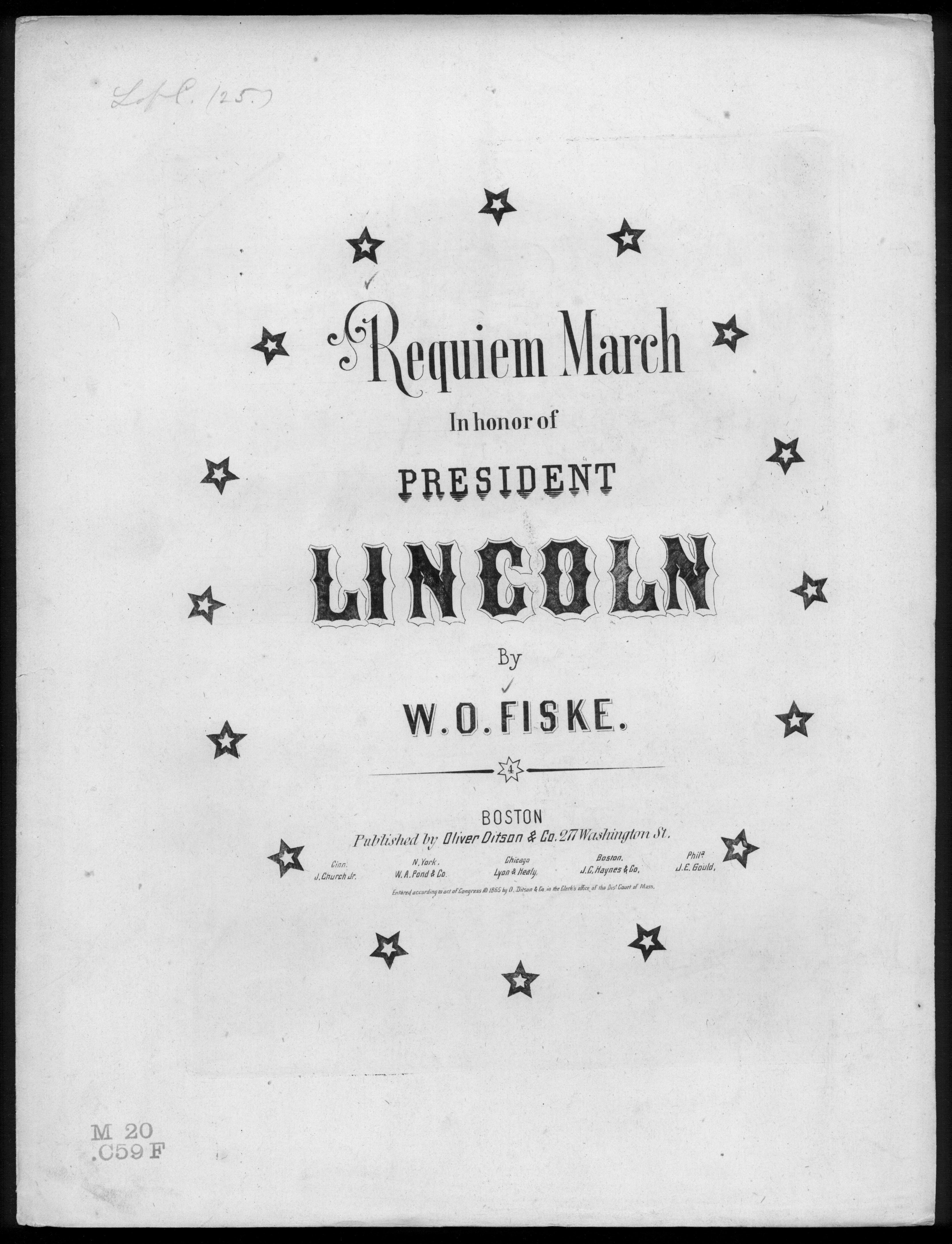
-
Description
This is sheet music for President Lincoln's funeral march for solo piano. The title on the cover page is "Requiem March In honor of President Lincoln," while the first page of music lists the title as "President Lincoln's funeral march." A requiem is traditionally in a minor key and imitates the solemn, slow pace of a funeral procession. This piece is part of the Library of Congress Civil War Sheet Music Collection, associated with the Union side. Probably a third of the entire U.S. population at the time, out of a total of 31 million, participated in some kind of memorial commemoration for Lincoln. Roughly 150,000 people were present at Lincoln's funeral in Springfield.
-
Source
-
Rights
Public Domain. Suggested credit line: Civil War Sheet Music Collection, Library of Congress, Music Division.
-
Creator
Fiske, W. O.
-
Publisher
Boston: Oliver Ditson & Co., 1865
-
Date
May 1, 1865
-
Material
Sheet Music


